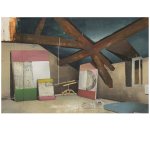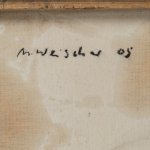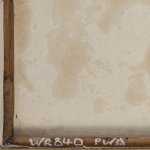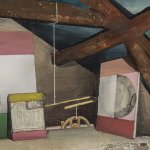Lot: 1042
Matthias Weischer (1973 Elte - lives and works in Leipzig)
'Studio', 2005
Oil on canvas. 55.0 x 85.0 cm (21¾ x 33¾ in) (canvas), 61.0 x 91.2 cm (frame). Signed on the reverse: M. Weischer and dated: (20)05 (black fiber pen). Framed in a wooden floater frame.
Provenance: Galerie EIGEN + ART, Berlin; Christie's, Post-War and Contemporary Art (Evening Sale), 20 June 2007, lot 99; private collection; Geoffrey Diner Gallery, Washington, DC.
Exhibitions: Venice - 51st Biennale Internazionale dell'Arte di Venezia, The Experience of Art, June - September 2005; Aachen - Ludwig Forum for International Art, Matthias Weischer. Painting, February - March 2006.
Hammer Price: 34,000 €
29. June 2023 at 4:30 PM CEST
Literature:
Conference paper Art Prize of the Leipziger Volkszeitung: Matthias Weischer, Cologne 2005, p. 83; Exh. cat. Matthias Weischer - Gemälde, Painting (ed. by Markus Stegmann), Museum zu Allerheiligen Schaffhausen, May 13 - August 12, 2007, Kunsthalle Mannheim, September 22, 2007 - January 1, 2008, Gemeentemuseum Den Haag, January 12 - 13 April 2008, Ostfildern 2007, p. 143.
The artist Matthias Weischer, born in North Rhine-Westphalia, completed his studies in painting and graphic arts at the Leipzig Academy of Visual Arts (HGB) and graduated in 2000. Subsequently, he was a master student of Sighard Gille for three years. In 2002, he joined forces with ten other former students of the HGB to found the gallery Liga with Christian Ehrentraut at its head - resulting in the term "Neue Leipziger Schule". After two successful, creative years that saw many exhibitions by the group of artists on the premises of the old cotton mill in Leipzig, the collaboration of the Liga ended, but Weischer's success story continued to gain momentum. He was represented by Judy Lybke and his gallery EIGEN+ART, who - a decade earlier - had already established Neo Rauch on the American art market. In 2004, Weischer was selected for the Rolex Mentor and Protégé Arts Initiative grant project alongside none other than David Hockney; reciprocal visits between the two artists followed, and Weischer got inspirations from his British role model.
Weischer began drawing and painting as a teenager; at 32, he was awarded the Leipziger Volkszeitung art prize. His works were already being traded on the secondary market at such a young age. They were shown at solo and group exhibitions in Germany and abroad, such as in Miami, London and at the 51st Venice Biennale. And Weischer himself was drawn out into the world: in 2007 he left Leipzig for a fellowship at the Villa Massimo in Rome; following the move, moreover, his œuvre, which until then had been dominated by interiors, expanded to include landscape depictions. After his return to Germany, Matthias Weischer designed stage decorations for the Ruhr Festival as well as for the Mannheim Opera, and in painting his focus returned again to the depiction of interiors.
Weischer draws the viewer's gaze into segments of a room. Often, the sparse and, above all, deserted living spaces look like arrangements from the 1950s or 1960s due to the patterns of wallpaper and carpets or the design of the furnishings, as in Untitled from 2004. The impasto application of paint spreads out over the edges of the canvas and makes the haptic of the surface perceptible. At another point, the segments of the painting seem to be floating lightly, contrasting with and emphasizing the bulging brown layer of paint, which seems to dissolve upward due to the use of light delicate tones, but on the underside seemingly retreats into the space. Likewise, the ornamented surfaces contrast with the unadorned, modern, worn walls and floor. He counters tectonic and gridded planes with color and playfulness.
In other tableaux, such as 'Studio' from 2005, the viewer sees part of an artist's studio with thick, dark wooden beams emerging from the wall from almost every direction, thus emphasizing the painterly sense of depth through their progress across the room. This contrasts with the two-dimensional paintings with geometric, colorful compositions that lean against the walls of the artist's studio.
Matthias Weischer combines different eras and styles. Elements from the past are present in his works, and yet it is not a nostalgic image of days gone by. New pictorial worlds emerge that captivate the viewer.
Step inside!
Read our Terms & Conditions.








